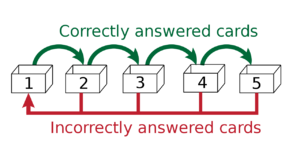Spaced Repetition: Difference between revisions
(Created the Spaced Repetition page) |
m (Formatting) |
||
| Line 18: | Line 18: | ||
[https://apps.ankiweb.net/ Anki - Spaced Learning with Flashcards. Open source] | [https://apps.ankiweb.net/ Anki - Spaced Learning with Flashcards. Open source] | ||
[https://duolingo.com/ Duolingo - Popular language learning platform that also uses Spaced Learning in some areas] | [https://duolingo.com/ Duolingo - Popular language learning platform that also uses Spaced Learning in some areas] | ||
[https://www.memrise.com/ Memrise - Flashcard based language learning with a version of Spaced Learning] | [https://www.memrise.com/ Memrise - Flashcard based language learning with a version of Spaced Learning] | ||
[https://synap.ac/ Synap - Spaced Learning platform using Multiple Choice Questions, rather than flashcards. ] | [https://synap.ac/ Synap - Spaced Learning platform using Multiple Choice Questions, rather than flashcards. ] | ||
Latest revision as of 18:04, 3 November 2017
Overview
Spaced Repetition (also known as Spaced Learning, Spaced Retrieval, Spaced Practice) is an educational theory emphasising the importance of re-visiting pieces of information at increasing time intervals, in order to commit it to long-term memory. The theory was first postulated by Hermann Ebbinghaus in the 1800's, and has since been developed and adapted into various formulations. Most famously is the Leitner System (pictured below), whereby students place flashcards into a series of boxes (typically 1-5) representing the current frequency with which they are meant to practice (i.e. Daily, Every other day, Weekly, Fortnightly, Monthly). On answering a question correctly, the student moves the card into a less frequent box, and if they answer it incorrectly, it goes back to the first (daily) box.
Applications
Spaced Repetition can be used across a range of fields as a way learn more in less time. Essentially, the practice provides a more systematic framework for revisiting and prioritising study. Under Spaced Repetition, students trust the 'algorithm' (whether paper or computer based) to tell them what they should be practicing each day, as opposed to self-selecting topics which may introduce a level of bias.
Research
A number of studies have been conducted looking into the benefits of Spaced Learning.
Web Based Platforms
Whilst traditionally studied using paper flashcard 'decks', over the last decade a number of web and mobile-based platforms have been made available - many of which are free or under open source licenses. Some of these are listed below:
Anki - Spaced Learning with Flashcards. Open source
Duolingo - Popular language learning platform that also uses Spaced Learning in some areas
Memrise - Flashcard based language learning with a version of Spaced Learning
Synap - Spaced Learning platform using Multiple Choice Questions, rather than flashcards.
